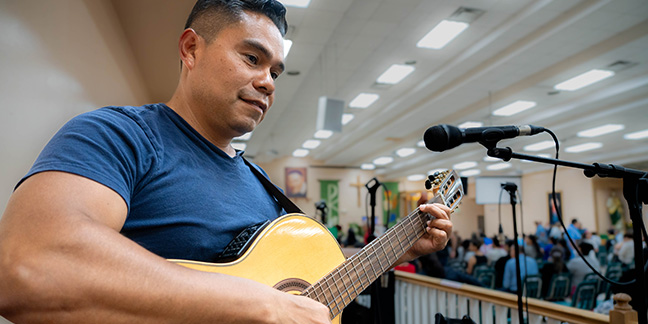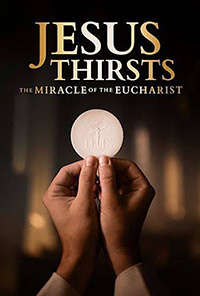‘Cantemus Domino’
 Juan Manuel Cajero, choir director at Our Lady of Guadalupe Parish in Charlotte, talks about the release of a new CD that includes songs with original music and lyrics. ( César Hurtado | Catholic News Herald)
Juan Manuel Cajero, choir director at Our Lady of Guadalupe Parish in Charlotte, talks about the release of a new CD that includes songs with original music and lyrics. ( César Hurtado | Catholic News Herald)
CHARLOTTE — Our Lady of Guadalupe Parish recently released its third musical production, “Cantemus Domino,” under the guidance of its longtime music director, Juan Manuel Cajero.
Cajero composed and produced the religious-themed collection, a series of psalms and reflections set to original music.
Each of the themes includes a personal reflection by priests who have served at the Charlotte parish over the years. One of the songs includes a reflection from his own brother, Father José Luis Cajero Ramos, who died unexpectedly in April at only 38 years old. A priest for seven years, Father Cajero served at Our Lady of Guadalupe Parish during the summer months of 2013 and 2015.
Cajero describes the musical collection as “psalms for healing, for forgiveness, for moments of sadness and melancholy, for thanksgiving.”
A native of Mexico, Cajero says he always had a taste for the religious music that he heard growing up in his Catholic home.
Inspired by seminarians who visited his parish while on their missionary travels, Cajero entered the minor seminary of Guadalajara when he was just 15 years old. There he learned music theory and Gregorian chant. He became interested in piano but was disappointed because the rigorous studies of seminary life left him little time left over to pursue music.
In 2002 he visited Charlotte while on vacation and met a priest who would shape his life: Vincentian Father Vincent Finnerty, then pastor of Our Lady of Guadalupe Parish. Father Finnerty invited him to stay in Charlotte and discern the priesthood with his religious order.
Cajero enrolled in classes at Central Piedmont Community College, studying philosophy and psychology as part of his vocation discernment process, but music was still beckoning him. He switched to music classes and joined the college’s opera group.
Cajero became convinced that music – not priestly ministry – was how God was calling him to serve the Church. In 2004 Father Finnerty put him in charge of the parish choirs, and Cajero didn’t look back.
A year later, his musical skills were brought to bear for a special occasion at Our Lady of Guadalupe Parish: the ordination of a Vincentian priest. Cajero and the choir rehearsed new material, and Father Finnerty liked it so much he asked them to record it on a CD.
“A New Day Dawns” was their first production, but it wouldn’t be their last.
Cajero and the parish choir planned to release a second CD with original music, but the COVID-19 pandemic delayed their efforts. In 2023, “Let God Win” was finally released. Among the songs was an original composition Cajero had created as the entrance song at his wedding: “Yo te acepto a ti.”
Cajero, now father of three children – Sofía, Natalia and Emmanuel – does not know what God has planned for his future, whether it’s writing more music, focusing on his family life or something else. His additional duties as a tribunal advocate at the parish are also fulfilling, he says.
“I want to continue studying and growing. I want to finish canon law to help my community, especially the non-English speaking community. I feel very sorry for people who cannot receive Communion. This helps them to rebuild their lives.”
Yet, Cajero adds, he will never give up music entirely. And he is already preparing a new production that he plans to call “What I Believe In,” he says, “where I will sing to women, to family, to life.”
— César Hurtado
 The National Eucharistic Revival that began in 2022 came to the big screen with the June 4 premiere of the educational and energizing documentary “Jesus Thirsts: The Miracle of the Eucharist” (Fathom Events). Written and directed by Tim Moriarty, the roughly 90-minute film proved sufficiently popular that it returned to theaters earlier this week.
The National Eucharistic Revival that began in 2022 came to the big screen with the June 4 premiere of the educational and energizing documentary “Jesus Thirsts: The Miracle of the Eucharist” (Fathom Events). Written and directed by Tim Moriarty, the roughly 90-minute film proved sufficiently popular that it returned to theaters earlier this week.
An early sequence of person-in-the-street interviews illustrates the complex of problems the revival is meant to address and at least partially remedy.
These brief dialogues give viewers evidence of alienation from, or indifference to, the Church as a whole as well as an all-too-widespread deficient understanding of the nature of the Blessed Sacrament.
Perhaps as a result of poor catechesis, perhaps due to the secular, materialist worldview that has taken hold in many quarters, this random survey reveals a common view of the Eucharistic elements as no more than symbolic representations of the body and blood of Jesus – an outlook wholly at odds, of course, with the 2,000-year-old beliefs of the Catholic Church.
As those dedicated to Church teaching make clear throughout the movie, this abandonment of faith in the Real Presence has grave consequences. While dissolving one of the bonds most likely to keep believers actively connected to the Church – as well as one of the motives most likely to spur regular attendance at Mass – it also undermines respect for the priesthood.
To explain and vindicate the Church’s supernatural perception of what takes place at every celebration of the Eucharist, the filmmakers turn to theologians, priests and bishops, missionaries and converts. These include Marian Fathers Chris Alar and Donald Calloway, Sisters of Life Marie Veritas and Mary Grace and renowned biblical scholar Scott Hahn.
The most vivid presence on screen is that of St. Clare Sister Briege McKenna. An indefatigable champion of the priesthood – disheartening scandals and the weak state of the Church in her homeland of Ireland notwithstanding – she makes a compelling case for viewing each priest as a gift from God to the faithful. She’s equally forceful in talking about the value of the liturgy.
“You go to Mass to claim the victory that was already won for you,” Sister Briege explains. “And if you claim the victory, Satan can’t get near you.”
Viewers are also brought along on a globe-trotting journey to witness the impact of the Eucharist in widely divergent parts of the world. Locales visited range from a Texas prison and a small town in rural Uganda to a Norbertine abbey in California and New York City’s St. Patrick’s Cathedral.
The story of persecuted Vietnamese prelate Cardinal Nguyen Van Thuan (1928-2002) is particularly poignant. During a long imprisonment, most of it spent in solitary confinement, the cardinal’s family found ingenious ways to supply him with the bread and wine needed to celebrate Mass in his cell.
One especially valuable element of “Jesus Thirsts” is its placement, via reenactments, of the Eucharist within the wider context of salvation history. The connection of Jesus’ action at the Last Supper to such events as the first Passover, the gift of manna in the wilderness, the crucifixion and the appearance of the Risen Lord on the road to Emmaus are all highlighted.
While too sophisticated for small children, the documentary is likely to prove a formative – but also easy-to-enjoy – catechetical lesson for teens and adults alike. For theater locations and showtimes, go to www.JesusThirstsFilm.com.
— John Mulderig, OSV News

